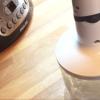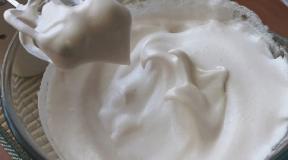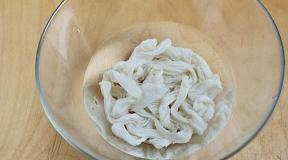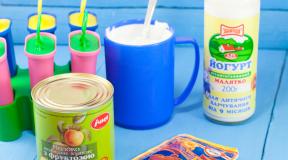When to collect urine from a baby girl. How to collect a urine sample from a newborn girl. Urine collection - morning activity
How to collect urine from a baby girl? Almost everyone had to deal with the delivery of urine for analysis. For an adult, the collection of biological material is not difficult, with children at the age of 2 this procedure is also easier, since the child is already old enough, and a 2-year-old can already be persuaded to "go" to the bank. And if it is necessary to do this for a very small child, the situation takes a different turn. Collecting tests from a baby can be difficult for parents who do not know how to collect urine from a baby. But with the observance of simple rules and techniques, this task is greatly simplified. What are the collection rules and how much urine is needed for the analysis of a baby?
Diagnosis of urine is one of the mandatory procedures for newly born children. A general analysis of the baby's urine, which was passed to the laboratory by the parents, plays an important role in determining the state of children's health and identifying possible pathologies.
So, the pediatrician issued a referral to take the baby's analysis. All known ways to do this are not suitable for a baby. What should parents do? How to collect urine from a newborn and find out exactly how much urine is needed for diagnosis?
From relatives, acquaintances, on the Internet on specialized forums for parents, you can read many tips on how to collect urine from a newborn girl or little boy. For example, many people say that "I collected by wrung out the diaper into which the child had just urinated." Despite the seeming obviousness, this method of donating is completely wrong: a baby urine sample, in addition to the actual liquid, will contain bacteria from the surface of the tissue, lint, dirt particles and other inclusions. They will reduce the value and reliability of the analysis to zero.
The same applies to the “pick it up by wringing out the diaper” decision. It will contaminate the urine with substances from its composition, in addition, the "diaper" for the liquid will work as a filter, removing fractions important for analysis from it. Another way that suggests itself is to collect urine from the nursery pot.
But such a sample for laboratory analysis will not work: the container for the collection should be as sterile as possible, and in the case of a pot, even the most thorough rinsing will not allow achieving the desired degree of purity. Do not collect liquid in this way, use a container specially designed for this.
The optimal container for collection, transportation and storage is a special container for analyzes or a glass jar. True, in the case of an infant, its use will be associated with certain difficulties: how to collect urine from a one-year-old girl, if the child still does not know how to control his urges, does not sit well, etc.?
The most practical ways to collect from, for example, a one-year-old toddler, will be:- use of urine bags;
- collection of urine from a child in a plastic bag.
The use of such methods also needs some training and understanding how much fluid is taken, but after mastering the technique, it will not be difficult for parents.

A child at 3 months, and even at 1 year, still does not know how to control the urge to urinate, and the release of fluid occurs as it accumulates. The usual number of small necessities for newborns, girls and boys is about 20 times a day. Children secrete about 30 milliliters of fluid at a time.
As already mentioned, collecting urine from a girl of 3 to 4 months, a month old baby and younger, is permissible in:- a special product - a urine bag;
- a clean bag or plastic diaper;
- sterile plastic jar;
- sterilized glass containers.
- Urine collection for newborns is done in the morning. Morning urine has maximum concentration and diagnostic value.
- The container must be sterile to protect the delivered volume of liquid from contamination.
- When collecting a sample for the laboratory, it is imperative to observe both your own hygiene and the baby. An adult should wash his hands with soap, and the child should be washed and wiped dry before the procedure.
- Parents often ask how much urine is needed for a general analysis. From 20 to 30 milliliters - this is the optimal volume for the general analysis of the child.
- The collected biological material should preferably be kept cool. If you leave the urine tests on the heat, microorganisms will begin to multiply there, other changes that affect the composition and result of the study will be transferred with urine.
- The analysis is important for speed: from collection to delivery to the laboratory should not be more than an hour and a half so that the urine retains its composition and does not become cloudy.
How many ml of urine should be taken for the analysis of the child? The volume should not be too small, but also too large; it is enough to hand over 30 milliliters; you do not need to bring a full jar to the laboratory.

Consider the question: how to properly collect urine from a baby? The techniques differ depending on the gender of the child. For example, it is permissible to collect urine from a baby boy by the “usual” method, in a sterilized glass / plastic jar. The necessary operation is rinsing and boiling the container. It is allowed to use washed mayonnaise jars, but it is advisable to use a special container from those sold in the pharmacy.
Next, the child is undressed and, as mentioned above, washed, followed by wiping dry (not forgetting about your own hygiene). The newborn is laid on a clean diaper, under which it is desirable to spread an oilcloth. The jar is placed under the penis.
The process may require some time and a fair amount of patience from an adult, since newborns cannot "go" on command - they will have to wait for the act of urination. An important nuance: the first drops must be skipped, since bacteria are washed off with the initial urine, and it is not suitable for accurate analysis. Having passed them, you need to collect the entire further stream in a jar. If the boy releases a plentiful stream that overflows the jar, the latter is simply pushed aside, there is no need to try to interrupt the child. The oilcloth placed ahead of time will protect from leakage.
After the process is complete, the jar is screwed tightly, and a sheet of paper with the name of the little patient is glued onto it (or attached to a regular rubber band), you can sign how much liquid has been collected. The container with urine, which was collected, should be delivered to the laboratory as soon as possible.
And how to collect the urine of a baby girl more correctly and more conveniently? Due to the anatomical structure of the genitals and urinary system of girls, the option with a can will not work. Without a urine bag, it is allowed to collect urine from a baby girl in a plate, then pouring the desired amount of urine into a container.
Preparing girls for urine sampling is similar to that for boys: containers are washed, boiled and wiped off. The girl is washed, paying attention to all natural folds, washing is done from the labia to the anus.
Next, a clean diaper is laid on the table, under which it is desirable to place an oilcloth to protect against leaks. The baby is put on the back, putting a plate under the girl's bottom. Now you need to wait for the girl to urinate. After it, the saucer is carefully removed from under the infant, and the liquid collected in it is poured into a jar prepared ahead of time.
To help doctors and parents who need to collect the child's urine for analysis, special devices were invented - urinals.

This product can be purchased at almost any pharmacy: it is affordable and versatile, suitable for a newborn of any gender (although there are models for boys, taking into account anatomical features). The urine collection bag is a sterile plastic bag, the base of which is provided with an adhesive layer. A scale for the amount of liquid is applied to the wall of the bag, and sometimes a sterile jar is included in the kit, which helps to carry the doctor exactly as much liquid as necessary. If not, it must be purchased separately.
How to collect an analysis with a urine bag:- Before carrying out the fence, you need to carry out hygiene procedures for yourself and the child.
- Get the device.
- Remove the original film. The prepared device is placed between the children's legs.
- The edge provided with an adhesive layer is glued to the child's skin: for girls, the urine bag is fixed around the labia, the fastening for boys is different - the penis is inserted inside the bag, the latter is fixed on the skin.
- Now you need to wait for the result, while waiting for the child you can pick it up.
- After urinating is complete, the bag is carefully peeled off. You can remember or write down how much urine was released by checking its volume on the scale on the bag.
- The lower part of the product is notched, and the liquid from it is collected in the required amount into a jar, which will be taken to the laboratory.
It is important to ensure that the bag does not come off while urinating or while waiting. The lower part of the tool (tapering) must point downwards.
Pros and cons of this method:- of unconditional merits - collecting urine from a baby for analysis by means of a special package is greatly simplified;
- the disadvantages include the fact that it is not always possible to pick up urine the first time. Therefore, it is advisable to purchase not one package, but several at once. As a rule, for the successful delivery of urine by an infant, two or three bags are needed, the second is most likely to come in handy.
Adaptations have some differences due to the gender of the child. So, the constructive of a special package for a boy provides for special recesses for the testicles. There are no special models for female babies, they purchase a universal package.

It is also possible "home" version of the device for the fence from the baby, made independently. In earlier years, samples were often collected in this way. This requires a new, clean bag with handles, preferably one that has not yet been opened. The handles are cut in such a way that the bag can be easily attached to the child's hips with their help. The further algorithm is similar to the sequence of actions for collecting urine for analysis in a "factory" urine collection bag. Holding the child upright, you must wait for the act of urination and filling the bag. Very young children are allowed to put them on a bed, covered with a clean diaper and oilcloth, and place a homemade bag under the buttocks.
A hand-made urine bag has an obvious plus - cheapness, availability and ease of manufacture, because there are bags in almost every home. But if you collect in it, sterility suffers: in this case it is impossible to completely get rid of contamination by foreign substances and bacteria.
The method may turn out to be inconvenient for parents of very active children: if the baby begins to move vigorously, there is a great chance that the homemade bag will slip. And in general, this option is not so convenient when compared with a pharmacy "branded" product.
Conclusion
Above, the main methods of collecting urine from a girl or an infant boy were outlined. After preparing and placing the saucer, bag or jar, you must wait for the young girl or young man to pee. But the wait can last quite a long time, and the baby is not yet able to do it "on demand".
In this case, he should try to help:- create the sound of overflowing water, stimulating children to urinate: for example, pouring water;
- stroking the baby's tummy in the area below the navel. The stroking hand should be warm;
- feed the baby or give him a drink;
- lower the child's palm into a plate filled with warm water;
- slightly wet the diaper under the toddler.
Young parents may be faced with the need to collect urine for analysis within a few weeks or months after the birth of a child. At first glance, how to collect urine from a baby does not raise any questions, because special devices have even been invented for manipulation. On the other hand, in practice, it is not so easy to get a baby to pee at the right time and do it carefully so that the material for research is informative.
The preparation of the baby requires special attention; there are some nuances in the approaches to collecting the product from the boy and from the girl. As a result of many years of trying, parents even developed several tricks with which you can not only do everything right, but also simplify the process as much as possible.
Rules for collecting urine for analysis in infants
To collect urine from a baby according to all the rules, it is necessary to adhere to a number of recommendations for preparing for manipulation and its implementation:
- Before collecting liquid for analysis, it is necessary to wash the child with soap or special cleaning compounds with antiseptic components. Particular attention should be paid to this point if you plan to collect material from the girl, you will have to carefully process each natural fold, moving from the pubic bone to the anus.
- Only morning urine is suitable for analysis. It is strictly forbidden to install a profile container on the body of children for collection in the evening, in order to collect the product in the morning.
- Liquid squeezed out of a baby's diaper or clothing will not give the correct picture. And diapers contain filler gels, so it's not a good idea to extract material from them either.
- If you take urine from a pot, the result will again be uninformative. No matter how diligently the container is washed, you still cannot get rid of all the microbes.
- The collected product must be handed over to the clinic within two hours after collection. It will be correct if the composition is in the refrigerator all this time.
Tip: There are many tricks you can use to speed up the urination process, but a very simple approach is the safest. You need to put on a diaper on your child all night, even if the goal is to collect urine from a one-year-old toddler who can sleep without a diaper. In the morning, after removing the diaper, the baby will pee soon. The main thing is to have time to wash it and prepare the necessary tools in the evening.

Urine collection bag for boys
- We turn on the water in the tap so that it gurgles, or we begin to pour the liquid in a thin stream from one container to another.
- With a warm hand, gently stroke the baby's belly just below the navel.
- You can give the baby a little warm water to drink. The main thing is not to try to water the baby even in the evening, this can lead to the appearance of edema, and the necessary liquid will come out during sleep.
- The option in which the baby's palm is lowered into a saucer or plastic container with warm water helps well.
- In extreme cases, you just need to wet the diaper on which the baby is lying. The water should be warm.
The above techniques work with equal success on a boy and a girl. If there is no result, then perhaps the baby simply has nothing to pee with and needs to give him some more water.
Using a urine bag
One of the most convenient devices for collecting urine from newborn children for analysis is the urine collection bag. The main thing is to use not a universal, but a profile product. It is a plastic bag with a hole of a certain shape, which is attached to the child's skin between the legs with Velcro from a safe adhesive. If done correctly, the urine will collect neatly in a sterile container and will not leak out.

The rules for using the item are simple:
- We wash the baby, wipe it dry with a clean towel and put it on the back.
- We talk with the baby, trying to calm him down. As soon as the baby stops fiddling, we attach the product to the external genitals according to the instructions on the package. You need to act carefully, but confidently, moving from bottom to top, otherwise the fit will be loose.
- Then we just wait until the child fills the bag with material, if necessary, stimulating the process in one of the above ways. You don't need to put on a diaper, even if things don't happen as quickly as needed. It will squeeze the container and drain the contents.
- The resulting product cannot be taken directly in this form to the clinic, it must be poured into a sterile jar.
This method is best suited for collecting urine from a boy, even if he is not even a month old. It is important to understand that the bag is a disposable item and should not be reused after cleaning.

Urine collection bag for girls
Traditional collection of urine in a jar
One of the most common approaches is to use a jar. Before collecting urine from a newborn in this manner, it is recommended that you prepare a simple plastic bag. We wash the kid according to all the rules and put it on the back. Next, we carry out the following manipulations:
- We take the bag and put it under the baby, fix it to the baby's legs. Then we carry out techniques to stimulate urination.
- We take a jar and wait. In children, as in adults, it is recommended to collect "average" urine whenever possible. It is with the help of a jar that this is easiest to do.
- We immediately close the collected product with a lid and go to the clinic, you do not need to pour it several times.
With this approach, you can use oilcloth, but it is cool and gives the baby discomfort. And even so, collecting the product for analysis is much more reliable, the excess liquid will definitely not leak out anywhere, but will be collected in a bag.

The above method is handy when working with boys. How to collect urine from a girl? In this case, the option with a plate is most suitable. True, it will not be possible to collect the "average" portion of the product, but if the baby is properly prepared, the composition for analysis will be optimal. The collection of material is carried out according to the following scheme:
- We take a sterilized shallow dish, it should be warm.
- We put the prepared girl on the back, put a plate under it. Place an oilcloth under the plate, just in case. The dishes should not have sharp edges; in such conditions, the baby will refuse any action.
- We wait patiently until the girl does all the work, after that we collect the product in a sterile dish, and wash the baby with warm water.
If urine collection is delayed for unknown reasons, you need to make sure that the child is comfortable. It is difficult to achieve the desired result from children who are distracted by something from the task at hand.

Collecting urine in a bag
Sometimes it happens that in the evening there was no time to run into the pharmacy for the necessary arsenal of devices, and the analysis must be taken in the morning. In this case, you can use a proven, but not the most convenient and reliable method. To do this, you need to take a clean plastic bag, preferably from fresh packaging, and not used to store food. It is good if the upper part is with handles, otherwise you will have to make cuts on the material. We act according to the following plan:
- The package must be fixed between the legs of the child like a urine bag. To do this, we tie the upper part around the hip joints, trying not to overtighten.
- A baby that is not at least 2-3 months old can be laid out on the back, but in this case you will have to put an oilcloth under it, the design is not the most reliable. It is better to hold the toddler in an upright position, then the process will go faster.
- After collecting it for analysis, we pour the material into a sterile container; the package cannot be taken to the clinic. It should be borne in mind that with this approach, the conditions of sterility are almost not met, so one cannot count on the information content of the product.
Having finally received the urine for analysis, it is necessary to correctly draw up the jar, if necessary, and take it to the clinic. If the manipulation was carried out in specific conditions or a package was used to carry it out, it is better to inform the laboratory assistant about this. Any nuance can affect the quality of the result and tell the doctor what caused the not entirely normal indicators. This should be done exactly when the product is handed over, and not in a specialist's office after the research has already been carried out.
Absolutely every person has come across the collection of urine for examination at least once in his life. And if in adulthood it is not difficult to collect urine, then with children everything is different. Especially if urine collection needs to be done from an infant. Do not panic at the thought of how to collect urine from a baby for analysis, because everything is actually not as difficult as it seems at first glance. There are a number of effective and easy-to-follow methods that have been tested by time and moms.
Methods for collecting urine for analysis in infants
When collecting urine, you can use the following containers:
- a special urine bag;
- glass or plastic containers;
- an ordinary clean plastic bag.
Using a urine bag
 In the pharmacy chain, sterile urine collectors are available for free sale, which are a small bag with a hole. It is quite easy to attach the urine bag with Velcro between the baby's legs, but it is better to purchase several bags just in case. Velcro is hypoallergenic, so you should not worry about possible irritation on the skin of the crumbs.
In the pharmacy chain, sterile urine collectors are available for free sale, which are a small bag with a hole. It is quite easy to attach the urine bag with Velcro between the baby's legs, but it is better to purchase several bags just in case. Velcro is hypoallergenic, so you should not worry about possible irritation on the skin of the crumbs.
It is not a good idea to place the urine collector under the diaper, as the result will be an empty bag and a swollen diaper.
 Before collecting urine from a baby, it must be thoroughly washed, and then a bag should be attached to its legs. To get the desired result faster, you can stand at the tap with open water. The kid should not sit in any case - the procedure is carried out while standing. If the child is too small and is not yet worth it, you will have to carry it in your arms. At the end of the procedure, the contents of the bag are poured into a sterile container.
Before collecting urine from a baby, it must be thoroughly washed, and then a bag should be attached to its legs. To get the desired result faster, you can stand at the tap with open water. The kid should not sit in any case - the procedure is carried out while standing. If the child is too small and is not yet worth it, you will have to carry it in your arms. At the end of the procedure, the contents of the bag are poured into a sterile container.
Video instruction: How to use a urine bag. Collecting a urine sample from a newborn
Note to moms!
Hello girls) I didn't think that the problem of stretch marks would touch me, but I will also write about it))) But there is nowhere to go, so I am writing here: How did I get rid of stretch marks after childbirth? I will be very glad if my method will help you too ...
Using plastic or glass containers
For this method, you can use a plastic urine collection container purchased from a pharmacy, or any small, clean jar in your home. Containers from juice or baby food are quite suitable. It is better to pour boiling water over the glass container.
Babies urinate at regular intervals, which can be detected with a watch. And if mom missed one such process, then it's better to keep the jar ready for the next. At the same time, there will be no unnecessary questions about how to collect urine from a boy - it is enough to substitute the container under the stream. A different method will work for girls, as this method will require another person holding the jar.
Using a plastic bag
 There are situations when, for some reason, it was not possible to purchase a urine collector, and container is not a way out. You can take an ordinary transparent plastic bag with handles, cut the handles so that they can be tied around the legs, make small cuts in the bag on the sides and fasten it to the child. As a result, a pouch is formed where urine is collected. The baby should be kept upright, and after urinating, the contents of the bag are carefully poured into a sterile jar.
There are situations when, for some reason, it was not possible to purchase a urine collector, and container is not a way out. You can take an ordinary transparent plastic bag with handles, cut the handles so that they can be tied around the legs, make small cuts in the bag on the sides and fasten it to the child. As a result, a pouch is formed where urine is collected. The baby should be kept upright, and after urinating, the contents of the bag are carefully poured into a sterile jar.
This method will help solve the problem of how to collect urine from a girl, since it is universal for both sexes. If the baby cannot stand due to her age, she can be put on an unfolded bag, after having laid an oilcloth. It's okay that some of the urine will pour out - the remaining amount is quite enough for the examination. The bag can also be tied around the legs and take the crumbs on the handles in a horizontal position. Babies are prone to urination during meals, so it is best to attach the baby to the breast to achieve quick results.
Surrounded by young mothers, there is always an "all-knowing" person who gives a lot of advice that is almost impossible to implement. Here are just a few of them:
- "Let the child pee calmly on the diaper or in the diaper - then you can twist it." The absorbent inside a modern diaper instantly turns urine into a gel. It is unlikely that such a substance will be accepted for examination in at least one laboratory. As for the diaper, you cannot get enough urine out of it, even if passed through the press. And if you add to this the particles of tissue fibers that fall into the collection container, you can immediately put an end to the results of the analysis.
- "Put the child on the pot and pour it into a jar." No plastic pot can be sterilized perfectly. Boiling water is not an assistant in this matter, and the most expensive household chemicals will not save you. The urine obtained in this way will contain an increased number of leukocytes, and the bacterial culture will be far from the true state of affairs.
We also read:
Often, young parents do not have the slightest idea how to properly collect a urine test from a nursing baby.
And no wonder, because adults are simple, and children still do not know how to control the "process" and will not be able to tell their mother when it is time to carry a jar for analysis.
Many do not think about this topic until the baby (God forbid) gets sick or the time comes. In some clinics, baby urine is tested when the baby is 3, 6, 9, and 12 months old.
How to properly collect a urine test from a nursing baby?
First, stock up on sterile containers. Special test jars can be bought at a pharmacy, or you can take a container available at home. The main thing is that the container is transparent and sterile (hold it over a boiling kettle for 15 minutes).
You need to collect urine in the morning, and it is important to act with lightning speed ... So put the jar in the bathroom in the evening. In the morning, do not miss the moment: as soon as the child wakes up in his crib, opens his eyes, take off his clothes, diaper - and a bullet into the bathroom!
The reliability of the results depends on your literacy in this matter, and, therefore, the health of the child
At this time, dad turns on a warm shower, and you quickly wash the baby with soap (after all the analysis must be taken only after ). Moreover, the girl needs to be washed from front to back so that bacteria do not get on the genitals. Then blot the baby with a clean towel and keep the jar ready - right now, most likely, the long-awaited "miracle" will happen.
If the little one does not dare to pass the analysis, help him with the good old "ps-ps-pss" and the sound of pouring water - a great way! Everything should go without complications and long expectations, because all the children write immediately afterwards.
You can also use a special urine bag designed specifically for babies. It is a bag (read "container"), which is attached to the external genitals of the child with a special sticky fastener - and the baby, without realizing it, takes the test. Do not be afraid: the crumbs will not have unpleasant sensations: he will not feel the special means. He will not bring an infection either, because all children's means for collecting urine are absolutely sterile! In addition, the Velcro is hypoallergenic, so the crumbs will not irritate the skin. You can buy such a urine bag at a pharmacy.
Rules for collecting urine from a child
1. Morning urine only ... After all, it will give the most informative result, and doctors recommend collecting the morning portion. In addition, it is convenient for parents, because in the clinic, tests are also taken in the morning, often from 8.00 to 9.00.
2. Fast delivery to doctors ... In the laboratory, urine should appear no later than three hours after collection. This is the only way you can get a reliable result.
3. Do not refrigerate ... The resulting "instance" cannot be cooled. If it is frosty or very cold outside, you need to wrap the test jar in a piece of warm cloth.
4. Do not give too much liquid before testing ... Before taking the analysis, you do not need to give your baby to drink more than usual. Indeed, after drinking plenty of water, the density of urine is greatly reduced, and the results will not be so reliable.
5. Lack of medication ... If before the child was prescribed medications or vitamin preparations, then it is better not to give them the day before the test. If it is impossible to stop taking them, you must warn the attending physician about this in advance.
Remember that it is very important to know how to properly collect a urine sample from a nursing baby. Indeed, the reliability of the results depends on your literacy in this matter, and, therefore, the health of the child.
After the long-awaited baby is born, her condition must be closely monitored in order to diagnose any disturbances in the functioning of the body in the early stages.
During the first year of life, each child is registered with his / her district pediatrician. The list of the main preventive measures includes: examination by narrow specialists (surgeon, neurologist, ophthalmologist and others), as well as the delivery of general clinical blood and urine tests in newborns.
When it comes to collecting urine from an infant, many parents are confused, because in reality it turns out to be not so easy. In this case, young mothers and fathers receive advice from relatives, neighbors, or they resort to the help of their imagination and ingenuity.
How to correctly collect urine from a baby girl's baby is detailed in this article, as well as questions about the rules for preliminary preparation for the procedure and typical mistakes during its implementation.
When is it necessary to test a child's urine?
All children, without exception, upon reaching the age of one month, are required to collect a urine test (for the prevention of any kind of deviation). If the situation follows, then in a three-month-old baby, in addition to examinations by narrow specialists, urinary sediment is additionally examined. Also, within the framework of dispensary observation, a one-year-old child is sent for general tests.

If your child at the age of one month has been assigned an examination, do not be alarmed - this is a necessary stage of his medical examination.
This may be due to the following situations:
- urinary sediment changes its natural color or smell, impurities visible to the naked eye appear in it, possibly traces of blood;
- during the act of urination, the infant begins to be very capricious, cry or pull his legs to the stomach;
- the number of episodes of urination becomes more frequent, and very little urine may be excreted;
- against the background of dysuric disorders, the temperature and other symptoms of intoxication (lethargy, apathy, tearfulness and others) increase.
Girl training rules
Collecting urine from a newborn girl, using modern devices, is not very difficult, it only requires a certain skill. An important role in the reliability of the results obtained is played by the principles of preliminary preparation of the baby.
It is necessary to collect a urine test in the morning, immediately after the child wakes up, until the moment of attachment to the breast. You should not store the received urine at home; it should be taken to the laboratory as early as possible. The longer the analysis stays in the container, the higher the risk of multiplication of pathogenic microbes in it, which will give a false result and will be misinterpreted in further diagnostics. During transportation of the analysis to the laboratory, make sure that the container is tight, as a weakly closed lid can cause infectious agents to enter it.

Morning urine is most informative, as it is concentrated as much as possible.
As soon as the baby wakes up, she must be thoroughly washed or treated with the labia. This is done in order to remove pathogenic microorganisms that have accumulated in large numbers overnight in the perineal area before the upcoming test, especially if the child was in a diaper.
The girl's genitals are washed from front to back, that is, in the direction from the vagina to the anus. It is forbidden to do this in the opposite direction, as there is a risk of infectious agents drifting from the rectum into the urethra or vaginal lumen.
To treat the labia, you can use a cotton pad, which is pre-moistened in warm clean water (the procedure is similar). It is not advisable to use perfumed cosmetics. Excess fluid on the genitals is removed with a dry, clean towel.

Washing a girl is a mandatory stage in preparing a child
Only after the appropriate preparation has been made, it is possible to collect the analysis using a special urine bag or other means. Remember to wash your hands thoroughly before collecting urine from your baby.
Methods for collecting urine in newborn girls and older children
You can collect urine from a girl in infancy in the following ways.
A urine collection bag that can be purchased at any pharmacy chain. It is quite simple to use, which does not require additional hassle. Urine enters the lumen of a special bag, without contacting the environment, which achieves the maximum sterility of the analyzes.
Before proceeding with gluing the urine bag, the child must be laid on his back and legs apart. The perineum is well washed by this time. At the time of fixing the device, the baby should be in a good mood, not be capricious and not cry. It is best to distract her with conversation or gentle stroking on her tummy.
Each urine bag contains a detailed description of the instructions for use and the zones of its fixation in children of different genders. Do not worry that the process of peeling off the bag will cause discomfort for the baby. As a rule, the process is not accompanied by absolutely no unpleasant sensations.
After the urine is in the receiver, it is immediately poured into a sterile container (cup), which is tightly closed with a lid.

Sterile container for collecting analyzes. It can also be purchased at any pharmacy. This method is more preferable for male babies, as their genitals are open, as a result of which it is easy to "catch" the stream of urine.
The disadvantage of this method is that when the container is open for a long time, it completely loses its sterility.
No modern doctor recommends using a regular package as an alternative to the collection. Since the method is quite routine and carries more disadvantages than advantages.
Bladder catheterization is performed according to certain indications only in a hospital setting.
You can collect urine from a one-year-old girl using any of the above methods. However, preference is given to collecting urine directly into a sterile container. In a year, the child can be explained the need to pee in a jar. It is also easier to perform all the manipulations for the preliminary preparation of the girl. It is best to bring the mid-range urine sample to the laboratory (if possible).
Currently, on the Internet, there are training videos that, in an easy and accessible form, help inexperienced parents to understand all the issues that interest them.

A urine reservoir purchased from a pharmacy is always completely sterile
How to get your baby to urinate?
Often, parents have a question about how to get their baby to urinate if she did it very recently (for example, while she was sleeping or at the time of washing). Do not despair, because infants urinate quite often, due to the peculiarities of their physiological development.
To stimulate your child to urinate again, you can use a number of tricks:
- make a gentle tummy massage, press on the area above the pubic bone and blow lightly on the girl's labia (it has been proven that when children are freezing, they pee much more often);
- give the baby a couple of drops of water on a spoon or apply it to the breast (most babies pee during feeding);
- turn on the water in the tap so that the murmur of water speeds up the process of emptying the bladder (you can also pour water from a glass into a glass).
It is worth relying on the child's behavior, as a rule, most children become quiet or grunt a little before they are about to urinate.

If the child cannot pee in any way, try to attach him to the breast, this will stimulate the process and will not affect the test result
How not to collect urine?
In order for the results of the analyzes obtained to give the doctor the most reliable picture of what is happening, it is worth adhering to a number of simple rules described above and collecting urine in special devices.
In this case, there are certain methods that are categorically incorrect, since they can cause the appearance of pathological impurities in the urinary sediment.
Never use the following procedures to collect urine:
- do not squeeze the diaper on which the baby urinated, or the diaper that was on it during the night's sleep for analysis;
- do not use urine from oilcloth, which is spread under the child;
- do not pour urine from the pot, even if it was washed well before;
- do not use non-sterile jars of mashed potatoes, jams and other food products;
- do not put a saucer under the girl's buttocks in which she should urinate;
- do not store the collected urine in the refrigerator or freeze it.

Any pot contains pathogenic microbes on its walls, so it cannot be used as a reservoir for collecting urine analysis
Any of the above methods lead to the fact that the laboratory receives analyzes that obviously contain pathogenic microflora that does not correspond to the true composition of the child's urine.
Conclusion
Currently, there is a lot of information on how to properly collect urine from children of different genders and age groups. You should not rely on the advice of your grandmothers, because modern methods of taking tests are available that facilitate this procedure and make it possible to obtain the most reliable results.



















